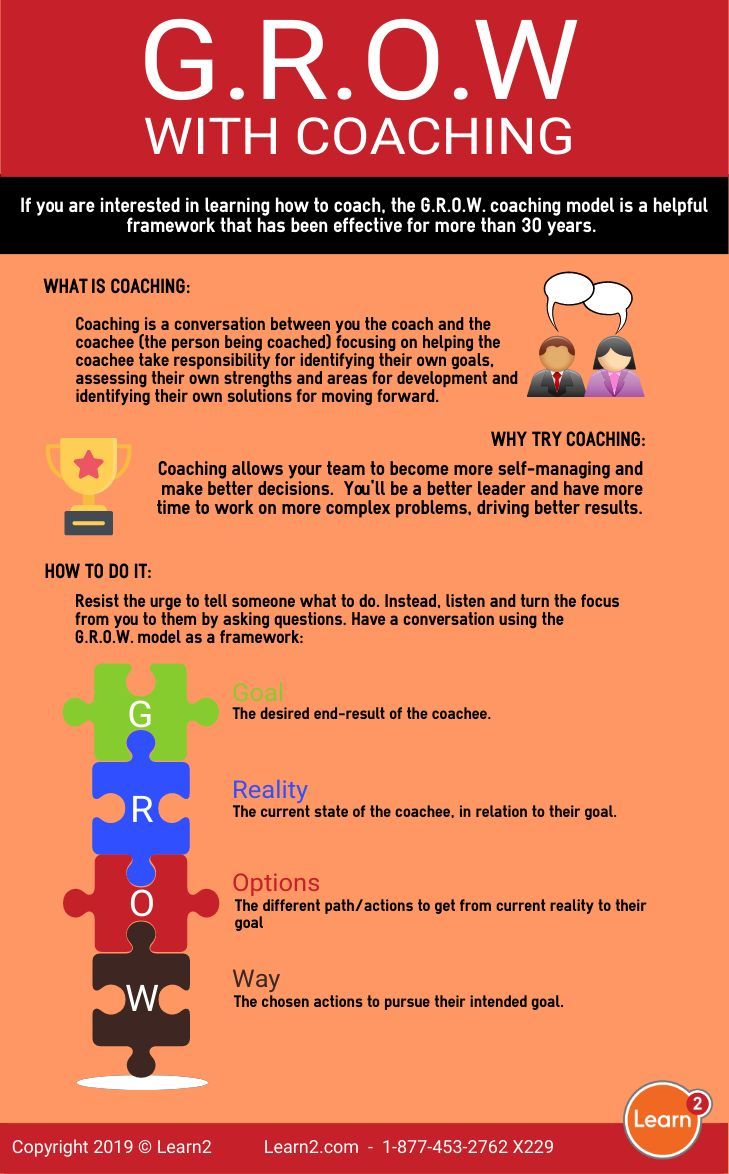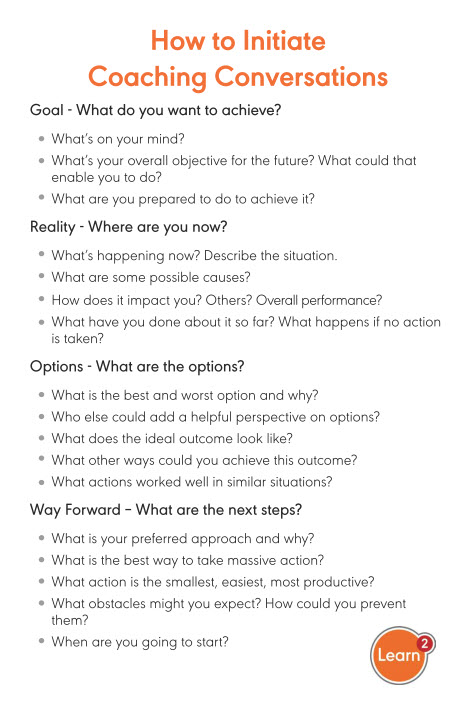
Resources and content to help you
apply GROW coaching.
Videos
Get to know this tool better
Resource
Tools for You and Your Team

You can download and print this poster for your office and meeting rooms to remind you and your team when and how to coach.

You can download and print this quick reference card for your leaders and teams to remind each other when and how to coach.
FAQ
I WANT TO COACH YET I DON’T HAVE TIME. WHAT DO I DO?
The most common misconception about coaching is that it takes longer. Your goal is to achieve BETTER results in LESS time. Most GROW coaching conversations take less than 5 minutes, and most are much less than 10 minutes.
With GROW Coaching, you focus on four questions with a bit of followup inside a focus. GROW Coaching focuses on a specific domain and allows you to ask some questions so the person gains insight and takes action. Many professional coaches dig into longer conversations of 30 minutes to an hour to explore multiple challenges. GROW coaching means you choose the focus and ask questions to illustrate your commitment to the person and their development.
Just like anything else, the more you practice, the faster and more comfortable you will be. Because with practice you get more comfortable. You will see that this approach replaces the way you have conversations now. Instead of telling leaders and teams what to you, you engage them to discover how to solve challenges on their own. You save time in the long run because you build capacity in others.
DO I TELL OTHERS I AM LEARNING? HOW?
Start with your leaders or your team to strengthen relationships and commitment to solving challenges. Your team will appreciate your support to remove their challenges. Practicing with your team gets you comfortable. Then encourage your leaders and teams to engage their teams. For your team you can choose challenges or opportunities. For sales teams, both can be exponentially valuable. rnThen gather peers together. Peer BrainTrusts are incredibly valuable as you gain an understanding of your peers’ greatest challenges or opportunities. Together you choose which increases alignment. Then together you share lived experience to solve a peer’s challenge. Many peers want to gather monthly to get updated on accountabilities because all leaders have a vested interest in the action plan getting implemented AND benefit from the business impact caused by solving challenges. Again peers want to gather monthly to solve another challenge while being upskilled through everyone’s lived experience.rnThen consider stakeholders. Customers thrive and rapidly develop trust when engaging in BrainTrusts. Deep insights in your stakeholders’ worlds improve prioritization, deployment of resources and planning. BrainTrusts deliver massive benefit to you and others. Frequently these lead to larger opportunities like client advisory boards where you can benefit from our facilitation experience and results show 97.4% retention of key accounts. rnAnd remember personal opportunities. We encourage application of learning and we count personal application as being equally valuable on the path to mastery. Personal BrainTrusts range from more formal settings like the parents council at a school, to siblings connecting or families exploring both challenges and opportunities.
HOW CAN I COACH IF I AM NOT KNOWLEDGEABLE ABOUT A SUBJECT?
The second most common misconception about coaching is that you have to be an expert. In fact, expertise means you are less likely to coach and more likely to tell. Too many leaders believe they add value by directing others what to do. Instead, you ask and you learn about their experience, their perspective, what options seem possible to them and how they would like to move forward.
You don’t have to be a subject matter expert to coach. You support someone else work through an issue that they know best using a proven process. In fact, there are advantages to not being a subject matter expert since you don’t have a bias and as a thinking partner, you can help the person work through different options and ways forward.
HOW DO I DO COACH VIRTUALLY?
Simple. Almost any conversation can be easily flowed into a coaching conversation with a question about their Goal or Reality or Options or Way Forward. You just ask a question. The same way you would face to face.
Often coaching is easier on the phone or over video. You really do not have to take someone for coffee or book a meeting room – that takes too long and can trigger anxiety for others. Especially if you are their boss!
Give notice unless you have a strong relationship. Say something like, “Hey let’s invest 10 minutes working through (insert focus). Love to hear how you think it through and what actions could accelerate.”
Keep it simple with focus. Start with a focus. Avoid starting with vague questions like, “How are you doing?” Instead start by asking a specific question about a focus so the coaching conversation will be complete in less than 10 minutes. Ask something like, “Where do you want to be on (insert project) in 30 days?” so the conversation is immediately framed for the person.
HOW DO I KNOW IF I AM COACHING PROPERLY?
There are two ways of knowing.
1. After the conversation, reflect on how much you listened, asked open-ended insightful questions and if the other person has a specific Way Forward.
2. Asking the other person, something like: “what was helpful about our conversation” or “how valuable was our conversation?”.
The key is to stop thinking that coaching is about you having the answers. Your role is to ask questions, listen, clarify and gain commitment to a way forward. If (and only if) its useful, you can share your lived experience to surface some more questions, options or ways forward. Yet remember that this is more about you than them! And makes the conversation last longer.
YOUR QUESTIONS MATTER TO US, YOUR PEERS AND YOU
We want your questions! All these questions come from you, our participants. We’ll answer your question so please click on the chatbot and ask us anything. Your question helps us and other leaders get clear on what’s required to move from learning to the performance environment. Ask a question now… please.
